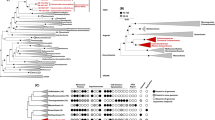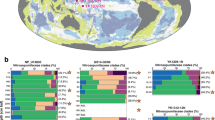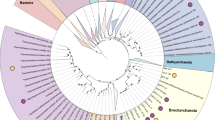Key Points
-
The archaeal domain is currently divided into two major phyla, the Euryarchaeota and the Crenarchaeota, based on the RNA component of the small ribosomal subunit (SSU rRNA).
-
During the past few years, uncultivated mesophilic crenarchaeota from marine and terrestrial environments have been identifed using PCR amplification of SSU rRNA. These archaea have been affiliated with Crenarchaeota, because they form a sister group of the hyperthermophilic crenarchaeota in SSU rRNA trees.
-
It was recently recognized that uncultivated mesophilic crenarchaeota include ammonium-oxidizers that might have an important role in the global nitrogen cycle.
-
Recently, the first genome sequence of a mesophilic crenarchaeota, Cenarchaeum symbiosum, was completed. This mesophilic 'crenarchaeon' was included in archaeal phylogenies that are based on the concatenation of ribosomal protein sequences.
-
Whereas C. symbiosum and related mesophilic crenarchaeota form a weakly supported sister group of hyperthermophilic crenarchaeota in a tree that combines SSU and large subunit (LSU) rRNA sequences, they have a robust basal position in a tree that is based on a concatenation of ribosomal proteins.
-
Genome mining shows that C. symbiosum lacks the typical crenarchaeal signatures, and instead has several characteristic euryarchaeal signatures.
-
These data indicate that C. symbiosum (and related mesophilic crenarchaeota) are distinct from hyperthermophilic crenarchaeota. We suggest that these ubiquitous archaea should form a third archaeal phylum and propose to name this new phylum Thaumarchaeota (from the Greek 'thaumas', meaning wonder).
Abstract
The archaeal domain is currently divided into two major phyla, the Euryarchaeota and Crenarchaeota. During the past few years, diverse groups of uncultivated mesophilic archaea have been discovered and affiliated with the Crenarchaeota. It was recently recognized that these archaea have a major role in geochemical cycles. Based on the first genome sequence of a crenarchaeote, Cenarchaeum symbiosum, we show that these mesophilic archaea are different from hyperthermophilic Crenarchaeota and branch deeper than was previously assumed. Our results indicate that C. symbiosum and its relatives are not Crenarchaeota, but should be considered as a third archaeal phylum, which we propose to name Thaumarchaeota (from the Greek 'thaumas', meaning wonder).
This is a preview of subscription content, access via your institution
Access options
Subscribe to this journal
Receive 12 print issues and online access
$209.00 per year
only $17.42 per issue
Buy this article
- Purchase on Springer Link
- Instant access to full article PDF
Prices may be subject to local taxes which are calculated during checkout



Similar content being viewed by others
References
Pace, N. R. A molecular view of microbial diversity and the biosphere. Science 276, 734–740 (1997).
Woese, C. R. & Fox, G. E. Phylogenetic structure of the prokaryotic domain: the primary kingdoms. Proc. Natl Acad. Sci. USA 74, 5088–5090 (1977).
Fox, G. E. et al. The phylogeny of prokaryotes. Science 209, 457–463 (1980).
Woese, C. R. Bacterial evolution. Microbiol. Rev. 51, 221–271 (1987).
Woese, C. R. in Archaea: Evolution, Physiology and Molecular Biology (eds Garrett, R. A. & Klenk, H. P.) 1–15 (Blackwell publishing, Oxford, 2006). An eloquent historical review that reported, for the first time, all the steps that led to the discovery of Archaea. Forms the introduction of an interesting book that covers the various aspects of archaeal physiology and molecular biology and focuses on the similarities between Archaea and Eukaryotes.
Woese, C. R., Kandler, O. & Wheelis, M. L. Towards a natural system of organisms: proposal for the domains Archaea, Bacteria, and Eucarya. Proc. Natl Acad. Sci. USA 87, 4576–4579 (1990).
Woese, C. R., Gupta, R., Hahn, C. M., Zillig, W. & Tu, J. The phylogenetic relationships of three sulfur dependent archaebacteria. Syst. Appl. Microbiol. 5, 97–105 (1984).
Prangishvilli, D., Zillig, W., Gierl, A., Biesert, L. & Holz, I. DNA-dependent RNA polymerase of thermoacidophilic archaebacteria. Eur. J. Biochem. 122, 471–477 (1982).
Makarova, K. S. & Koonin, E. V. Comparative genomics of archaea: how much have we learned in six years, and what's next? Genome Biol. 4, 115 (2003).
Brochier, C., Forterre, P. & Gribaldo, S. An emerging phylogenetic core of Archaea: phylogenies of transcription and translation machineries converge following addition of new genome sequences. BMC Evol. Biol. 5, 36 (2005). Revealed a conserved core of vertically inherited genes in different cellular systems, which proved that reconstructing the phylogeny of species is a feasible task in Archaea.
Gribaldo, S. & Brochier-Armanet, C. The origin and evolution of Archaea: a state of the art. Phil. Trans. R. Soc. Lond. B 361, 1007–1022 (2006).
Daubin, V., Gouy, M. & Perriere, G. A phylogenomic approach to bacterial phylogeny: evidence of a core of genes sharing a common history. Genome Res. 12, 1080–1090 (2002).
Wolf, Y. I., Rogozin, I. B., Grishin, N. V., Tatusov, R. L. & Koonin, E. V. Genome trees constructed using five different approaches suggest new major bacterial clades. BMC Evol. Biol. 1, 8 (2001).
Forterre, P., Gribaldo, S. & Brochier-Armanet, C. in Archaea: Evolution, Physiology and Molecular Biology (eds Garrett, R. A. & Klenk, H. P.) 17–29 (Blackwell publishing, Oxford, 2006).
Bernander, R. Chromosome replication, nucleoid segregation and cell division in Archaea. Trends Microbiol. 8, 278–283 (2000).
Myllykallio, H. et al. Bacterial mode of replication with eukaryotic-like machinery in a hyperthermophilic archaeon. Science 288, 2212–2215 (2000).
Makarova, K. S. & Koonin, E. V. Evolutionary and functional genomics of the Archaea. Curr. Opin. Microbiol. 8, 586–594 (2005).
Klenk, H. P. in Archaea: Evolution, Physiology and Molecular Biology (eds Garrity, G. M. & Klenk, H. P.) 75–95 (Blackwell publishing, Oxford, 2006).
Uemori, T., Sato, Y., Kato, I., Doi, H. & Ishino, Y. A novel DNA polymerase in the hyperthermophilic archaeon, Pyrococcus furiosus: gene cloning, expression, and characterization. Genes Cells 2, 499–512 (1997).
Margolin, W., Wang, R. & Kumar, M. Isolation of an ftsZ homolog from the archaebacterium Halobacterium salinarium: implications for the evolution of FtsZ and tubulin. J. Bacteriol. 178, 1320–1327 (1996).
Allers, T. & Mevarech, M. Archaeal genetics — the third way. Nature Rev. Genet. 6, 58–73 (2005).
Olsen, G. J., Lane, D. J., Giovannoni, S. J., Pace, N. R. & Stahl, D. A. Microbial ecology and evolution: a ribosomal RNA approach. Annu. Rev. Microbiol. 40, 337–365 (1986).
DeLong, E. F. Archaea in coastal marine environments. Proc. Natl Acad. Sci. USA 89, 5685–5689 (1992).
Fuhrman, J. A., McCallum, K. & Davis, A. A. Novel major archaebacterial group from marine plankton. Nature 356, 148–149 (1992).
Schleper, C., Jurgens, G. & Jonuscheit, M. Genomic studies of uncultivated archaea. Nature Rev. Microbiol. 3, 479–488 (2005). A fascinating review that underlines the diversity of Archaea and the importance of using metagenomic approaches to gain insights into their biology and physiology.
Schleper, C. in Archaea: Evolution, Physiology and Molecular Biology (eds Garrett, R. A. & Klenk, H. P.) 39–50 (Blackwell publishing, Oxford, 2006).
Preston, C. M., Wu, K. Y., Molinski, T. F. & DeLong, E. F. A psychrophilic crenarchaeon inhabits a marine sponge: Cenarchaeum symbiosum gen. nov., sp. nov. Proc. Natl Acad. Sci. USA 93, 6241–6246 (1996).
Schleper, C., Swanson, R. V., Mathur, E. J. & DeLong, E. F. Characterization of a DNA polymerase from the uncultivated psychrophilic archaeon Cenarchaeum symbiosum. J. Bacteriol. 179, 7803–7811 (1997).
Garrett, R. A. & Klenk, H. P. (eds) Archaea: Evolution, Physiology and Molecular Biology (Blackwell publishing, Oxford, 2006).
Barns, S. M., Delwiche, C. F., Palmer, J. D. & Pace, N. R. Perspectives on archaeal diversity, thermophily and monophyly from environmental rRNA sequences. Proc. Natl Acad. Sci. USA 93, 9188–9193 (1996).
Hershberger, K. L., Barns, S. M., Reysenbach, A. L., Dawson, S. C. & Pace, N. R. Wide diversity of Crenarchaeota. Nature 384, 420 (1996).
Lopez-Garcia, P., Brochier, C., Moreira, D. & Rodriguez-Valera, F. Comparative analysis of a genome fragment of an uncultivated mesopelagic crenarchaeote reveals multiple horizontal gene transfers. Environ. Microbiol. 6, 19–34 (2004).
Robertson, C. E., Harris, J. K., Spear, J. R. & Pace, N. R. Phylogenetic diversity and ecology of environmental Archaea. Curr. Opin. Microbiol. 8, 638–642 (2005). A recent, exhaustive archaeal phylogeny that was based on an analysis of SSU rRNA sequences. Despite the use of a large number of sequences, this marker was unable to resolve the deepest nodes of the archaeal phylogeny.
Cubonova, L., Sandman, K., Hallam, S. J., Delong, E. F. & Reeve, J. N. Histones in Crenarchaea. J. Bacteriol. 187, 5482–5485 (2005).
Ochsenreiter, T., Selezi, D., Quaiser, A., Bonch-Osmolovskaya, L. & Schleper, C. Diversity and abundance of Crenarchaeota in terrestrial habitats studied by 16S RNA surveys and real time PCR. Environ. Microbiol. 5, 787–797 (2003).
Wuchter, C. et al. Archaeal nitrification in the ocean. Proc. Natl Acad. Sci. USA 103, 12317–12322 (2006).
Leininger, S. et al. Archaea predominate among ammonia-oxidizing prokaryotes in soils. Nature 442, 806–809 (2006).
Konneke, M. et al. Isolation of an autotrophic ammonia-oxidizing marine archaeon. Nature 437, 543–546 (2005). The first report of the isolation of a member of the Thaumarchaeota, and the first demonstration of the ability of an isolated archaeon to oxidize ammonium.
Nunoura, T. et al. Genetic and functional properties of uncultivated thermophilic crenarchaeotes from a subsurface gold mine as revealed by analysis of genome fragments. Environ. Microbiol. 7, 1967–1984 (2005).
Woese, C. R., Achenbach, L., Rouviere, P. & Mandelco, L. Archaeal phylogeny: reexamination of the phylogenetic position of Archaeoglobus fulgidus in light of certain composition-induced artifacts. Syst. Appl. Microbiol. 14, 364–371 (1991).
Boussau, B. & Gouy, M. Efficient likelihood computations with nonreversible models of evolution. Syst. Biol. 55, 756–768 (2006).
Hallam, S. J. et al. Genomic analysis of the uncultivated marine crenarchaeote Cenarchaeum symbiosum. Proc. Natl Acad. Sci. USA 103, 18296–18301 (2006).
Matte-Tailliez, O., Brochier, C., Forterre, P. & Philippe, H. Archaeal phylogeny based on ribosomal proteins. Mol. Biol. Evol. 19, 631–639 (2002).
Waters, E. et al. The genome of Nanoarchaeum equitans: insights into early archaeal evolution and derived parasitism. Proc. Natl Acad. Sci. USA 100, 12984–12988 (2003).
Slesarev, A. I. et al. The complete genome of hyperthermophile Methanopyrus kandleri AV19 and monophyly of archaeal methanogens. Proc. Natl Acad. Sci. USA 99, 4644–4649 (2002).
Gribaldo, S. & Philippe, H. Ancient phylogenetic relationships. Theor. Popul. Biol. 61, 391–408 (2002).
Huber, H. et al. A new phylum of Archaea represented by a nanosized hyperthermophilic symbiont. Nature 417, 63–67 (2002).
Brochier, C., Gribaldo, S., Zivanovic, Y., Confalonieri, F. & Forterre, P. Nanoarchaea: representatives of a novel archaeal phylum or a fast-evolving euryarchaeal lineage related to Thermococcales? Genome Biol. 6, R42 (2005).
Burggraf, S., Stetter, K. O., Rouviere, P. & Woese, C. R. Methanopyrus kandleri: an archaeal methanogen unrelated to all other known methanogens. Syst. Appl. Microbiol. 14, 346–351 (1991).
Brochier, C., Forterre, P. & Gribaldo, S. Archaeal phylogeny based on proteins of the transcription and translation machineries: tackling the Methanopyrus kandleri paradox. Genome Biol. 5, R17 (2004).
Bapteste, E., Brochier, C. & Boucher, Y. Higher-level classification of the Archaea: evolution of methanogenesis and methanogens. Archaea 1, 353–363 (2005).
Felsenstein, J. Cases in which parsimony or compatibility methods will be positively misleading. Syst. Zool. 27, 401–410 (1978).
Tatusov, R. L. et al. The COG database: new developments in phylogenetic classification of proteins from complete genomes. Nucleic Acids Res. 29, 22–28 (2001).
Forterre, P., Gribaldo, S., Gadelle, D. & Serre, M. C. Origin and evolution of DNA topoisomerases. Biochimie 89, 427–446 (2007).
Makarova, K. S., Wolf, Y. I., Sorokin, A. V. & Koonin, E. V. Clusters of orthologous genes for 41 archaeal genomes and implications for evolutionary genomics of archaea. Biol. Direct 2, 33 (2007). A dedicated COG database for Archaea that highlights the important differences between Thaumarchaeota and hyperthermophilic crenarchaeota.
Nicol, G. W. & Schleper, C. Ammonia-oxidising Crenarchaeota: important players in the nitrogen cycle? Trends Microbiol. 14, 207–212 (2006). Together with reference 37, this review revealed the unsuspected role of archaea in the global nitrogen cycle, which was previously assumed to be carried out by bacteria.
Forterre, P., Brochier, C. & Philippe, H. Evolution of the Archaea. Theor. Popul. Biol. 6, 409–422 (2002).
Edgar, R. C. MUSCLE: a multiple sequence alignment method with reduced time and space complexity. BMC Bioinformatics 5, 113 (2004).
Philippe, H. MUST, a computer package of Management Utilities for Sequences and Trees. Nucleic Acids Res. 21, 5264–5272 (1993).
Altschul, S. F. & Koonin, E. V. Iterated profile searches with PSI-BLAST — a tool for discovery in protein databases. Trends Biochem. Sci. 23, 444–447 (1998).
Guindon, S. & Gascuel, O. A simple, fast, and accurate algorithm to estimate large phylogenies by maximum likelihood. Syst. Biol. 52, 696–704 (2003).
Acknowledgements
The authors thank G. Sezonov for suggesting the name Thaumarchaeota, E. Koonin for unpublished communications and the referees for useful comments and suggestions.
Author information
Authors and Affiliations
Corresponding author
Supplementary information
Supplementary information S1 (Table)
Test of three placements for mesophilic crenarchaeota (PDF 193 kb)
Related links
Related links
DATABASES
Entrez Genome Project
Candidatus Methanoregula boonei
Methanothermobacterthermautotrophicus
FURTHER INFORMATION
Céline Brochier-Armanet's homepage
Glossary
- Hyperthermophile
-
An organism that has an optimal growth temperature of at least 80°C.
- Paraphyletic
-
A group of organisms or sequences that includes an ancestor and some, but not all, of its descendants.
- Sister groups
-
In a phylogeny, two lineages that share an exclusive common ancestor.
- Monophyletic group
-
Includes an ancestor and all its descendants.
- Clade
-
A monophyletic group.
- Long-branch attraction artefact
-
A phylogenetic artefact that is induced by differences in evolutionary rates, and results in the artificial grouping of lineages that have long branches in a phylogenetic tree.
- Mesophile
-
This term is normally restricted to organisms that have optimal growth temperatures of between 20 and 50°C. Here, however, the term mesophilic crenarchaeota is given to all non-hyperthermophilic crenarchaeota, even though some of them (presently uncultivated) are psychrophiles (optimal growth temperature of between O and 20°C) or moderate thermophiles (optimal growth temperature of between 50 and 70°C).
Rights and permissions
About this article
Cite this article
Brochier-Armanet, C., Boussau, B., Gribaldo, S. et al. Mesophilic crenarchaeota: proposal for a third archaeal phylum, the Thaumarchaeota. Nat Rev Microbiol 6, 245–252 (2008). https://doi.org/10.1038/nrmicro1852
Issue Date:
DOI: https://doi.org/10.1038/nrmicro1852
This article is cited by
-
Increased prokaryotic diversity in the Red Sea deep scattering layer
Environmental Microbiome (2023)
-
Bacterial diversity in water from Xifeng Hot Spring in China
Brazilian Journal of Microbiology (2023)
-
Phylotype resolved spatial variation and association patterns of planktonic Thaumarchaeota in eastern Chinese marginal seas
Marine Life Science & Technology (2023)
-
Conserved and lineage-specific hypothetical proteins may have played a central role in the rise and diversification of major archaeal groups
BMC Biology (2022)
-
Gut archaea associated with bacteria colonization and succession during piglet weaning transitions
BMC Veterinary Research (2022)



